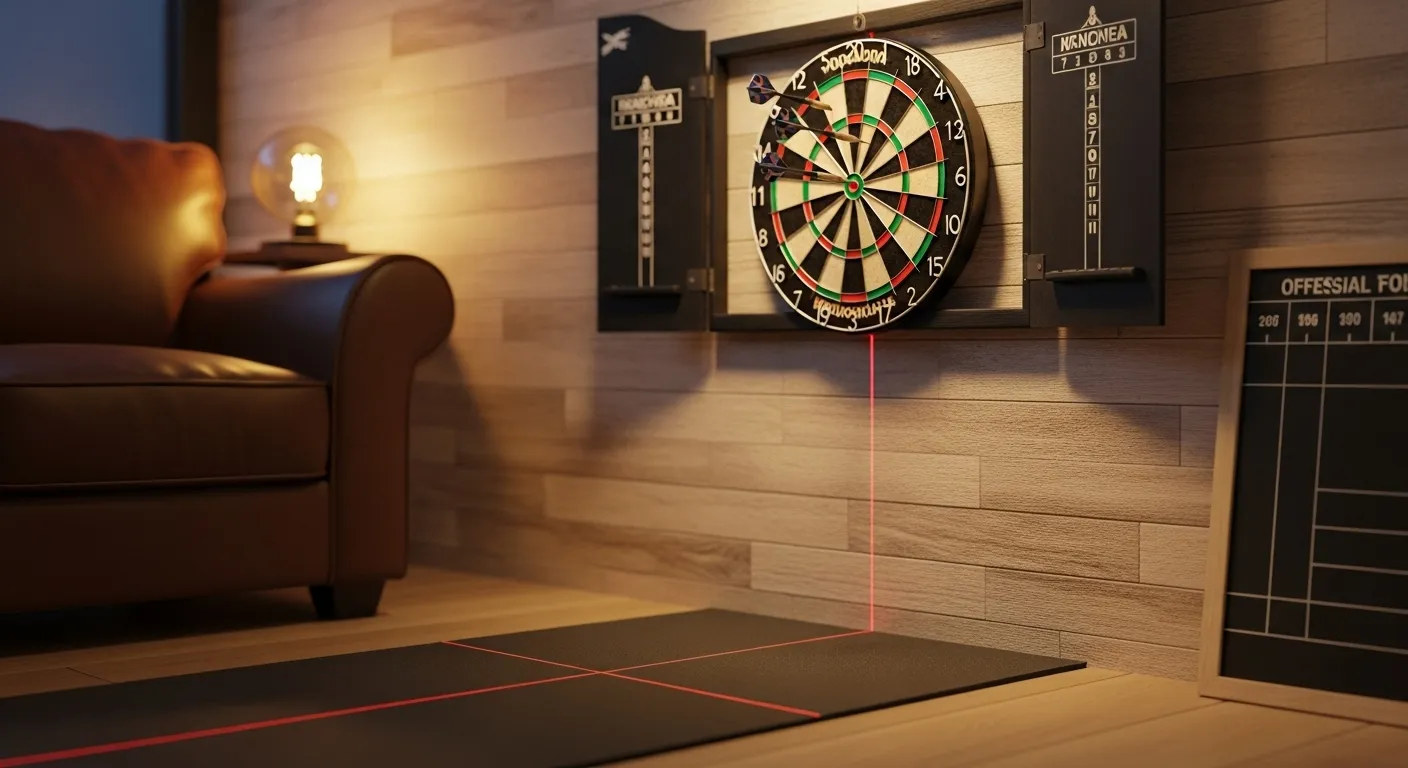Introduction to Darts Scoring
So, let’s just get into it. I don’t want to over-polish every sentence. It’s one of those topics where people think they “kinda know,” but when you actually sit with the dartboard, the darts scoring logic isn’t as obvious as beginners assume. Everyone thinks, “Oh, the bullseye is the max point.” Which is hilarious because, in steel tip, that’s not even true. Trip 20 is king. That tiny little red ring basically runs entire tournaments.
Darts Scoring Systems
Before I dive into specifics, it’s important to know that darts scoring rules aren’t ONE set. There are sub-systems depending on the game variation, board type (steel vs soft), and even the ruleset used in leagues vs pubs.
For clarity:
- 501 (sometimes 301) is the most common competitive game and ends in double out rules.
- Soft tip darts use machines that handle counting, while steel tip requires human recording.

The Layout of a Dartboard
Let’s start simple: the layout. People don’t memorize the dartboard scoring numbers in order—and they shouldn’t, unless they’re going pro or want to be the guy in the group chat sending overly confident advice. The dartboard isn’t numerically symmetrical; it’s strategically arranged to punish inaccuracy.
That’s why, next to 20, you’ll find 1 and 5—the system punishes sloppy aim. Most beginners don’t realize how intentional the layout is. Brian Gamlin, the designer (around 1896), arranged value zones so that missing your intended target costs you significantly. In a weird life parallel, the game rewards precision and punishes “close enough.”
- The outside thin ring = double points
- The inner thin ring = triple points
- Center green ring = 25 points
- Center red = 50 points
High-level players worship that inner thin ring, especially the triple 20. This is why darts triple and double ring scoring is such a big chunk of the learning curve. You can’t be average and win legs if you’re not exploiting those razor-thin scoring regions.

Common Mistakes Beginners Make
Now, let’s drag beginners through a few examples. You hit triple 20, that’s 60. That’s the highest scoring single dart possible. That’s why 180 (three triple 20s) is the crowd pop moment. Most casual players hear that number on TV and don’t really process what makes it special. They think, “Oh, because it’s high.” No. It’s the mathematically perfect scoring volley, and pro players hit 180s like it’s nothing. If you want to explore more about the different dart games and how they shape the sport, check out this article on top dart games.
Soft Tip vs Steel Tip Darts Scoring
Soft tip darts scoring sometimes uses a different bull scoring (often 50 for both rings) because the electronic scoring machines simplify things. In steel tip, you have to track the scores yourself.
- Soft tip → digital terminals handle the cognitive burden.
- Steel tip → humans still scribble numbers or maintain an old school chalk/whiteboard.
Yes, darts scoreboard setup still matters, and there are sketchy people who lie on bar nights. Like poker-night energy.

The 501 Darts Scoring System
This is the main format for modern competition. Players start with 501 points and subtract their score from each turn. The goal? Reach EXACTLY zero.
- You can’t go negative.
- You can’t “bust” lower than zero.
- Your last dart must land on a double, and that final double is known as double out.
Common 501 Misunderstanding
501 double out rules are probably the most misunderstood. At the endgame, players often panic. You’ll see a player at, let’s say, 40 left, and they emotionally lob a dart hoping for a bull—even though the correct decision is clearly double 20.
Most pros memorize “checkout routes.” Beginners scramble into chaos.
It’s not that they’re dumb. It’s that they haven’t built mental sequences yet. Strategy in darts is pattern memory. Not a philosophical genius.
Darts Scoring: Plain Language
Throw 3 darts, sum them, and subtract from your total. Pretty obvious, right? But this baseline is the skeleton most people don’t contextualize. In soft tip competitive leagues, players rarely need calculators because the machine does the math. In steel tip, online calculators are commonly used by nerdier pub groups to reduce math stress. To learn more about the rules every dart player must know, check out this article.”
“Cricket” Darts Scoring Method
Cricket is a side path, but it’s essential for anyone wanting to understand darts scoring fully. It’s not about getting down to zero. Instead, it’s about closing numbers 15 through 20 + bull and controlling points off them.
- Close means: 3 marks on that value (a triple counts as 3).
- You only score points on a number after you close it.
This creates a defensive, spiteful playing style, and is one of the few casual darts scoring systems where psychological warfare is obvious.
Darts Scoring Reference Table
| Region | Value |
| Single number bed | Face value |
| Double ring | 2x face value |
| Triple ring | 3x face value |
| Outer bull (green) | 25 points |
| Inner bull (red) | 50 points |
This table is a clean reference that even professional darts scoring sheets include in their header.
Steel Tip vs Soft Tip Dartboards: Key Differences
- Steel tip: Fiber board (usually sisal), bristles heal after darts are removed.
- Soft tip: Plastic board with tiny holes, darts have plastic tips.
Why does this matter? Because one of the sneaky differences most casuals don’t think about is the bull value.
- Steel tip bull: 25 outer / 50 center
- Soft tip bull: 50 for both rings
Soft tip is more forgiving, and electronic machines handle the scoring. On the other hand, steel tip involves manual tracking, and mistakes compound.
The Psychological Side of Darts Scoring
This is where the mental side of scoring separates casual players from the serious ones. The conversation of “talent vs aim” is often thrown around in casual circles, but real improvement isn’t about aim first. It’s about target selection. If you’re always aiming for the mathematically wrong zone, perfect accuracy means nothing. For more insights on match strategies and analysis, check out this article.
Darts Scoring Strategies That Actually Win Legs
The hot zones are NOT in the middle of the board. The hot zones are the triple bands.
- Triple 20 = 60
- Triple 19 = 57
- Triple 18 = 54
Pro players frequently pivot to T19 when the T20 bed starts getting crowded. Here’s where darts scoring strategies begin:
| Score Situation | Best Target |
| Early leg (high remaining) | T20 / T19 |
| Mid leg (trying to position) | T20 → T19 switch-offs if obstructed |
| Low scoring endgame | Setup a finish (like 32 or 40) |
| Closing shot | Specific double checkout |
Setup Darts Matter
Setup darts are underrated. They’re not flashy, and they don’t get applause, but they make winning easier. For example, when you’re 62, most casuals would think: “Oh, bull is 50, so one bull and something small.”
The correct thought process:
62 → T10 (30) → D16 (32)
or
62 → 12 → Bull (if the line is blocked).
Pros memorize these tiny routes to remove decision fatigue, reducing anxiety at low numbers.
Dart Scoreboard Setup Reality
Most casual dart scoreboards in bars are literally a chalk tile, a whiteboard, or a ripped paper menu turned sideways. Few bars have a high-contrast numeric scoreboard. The steel tip culture is about DIY scoring and how you keep score can even become a social trust metric. For tips on creating the perfect dart setup at home, check out this article.
Soft Tip vs Steel Tip Culture
- Soft tip: Machine counts, LED animations, loud noises, social dopamine feedback.
- Steel tip: Quiet, gritty, manual tracking, psychological tension.
The Psychological Collapse Moment: “Bust Fear”
When a player gets under 60, everything changes. The brain starts catastrophic. This is where 501 double out rules choke people.
Darts Scoring Fatigue
After about 40 minutes of play, beginners often slump. Not because their arm is tired, but because their brain is tired. This is why many pros look robotic—their muscle memory reduces mental load.
Conclusion
There’s no grand moral here, just the reality that most casual players think darts is simple. But underneath the surface, it’s layered with micro logic, arithmetic pacing, and emotional misfires. Once you start dialing into triples, the whole game changes character. And yeah, that’s usually where the hobby turns into obsession.
5 Real FAQs (People Also Ask)
- What is the best scoring strategy in darts?
Focus on triples early, then plan checkouts. Don’t chase the bull emotionally. - Why do pros aim for triple 20 instead of bull?
Because triple 20 is worth 60, while bull is only worth 50. - Is soft tip scoring different from steel tip scoring?
Yes. Soft tip machines often count the bull as 50 for both rings, while steel tip uses 25 outer and 50 inner. - What is the easiest double to finish on?
Most pros say D16 because it funnels downward cleanly into D8, D4, D2 if you miss. - How do you track darts scores properly?
On steel, use chalk or whiteboard. On soft tip, the machine counts, or you can use an online scoring calculator.

I’m Daniel Moore, and I live for the thrill of the game. Get energetic live commentary, detailed match analysis, data-backed betting predictions, and official team rankings right here.



